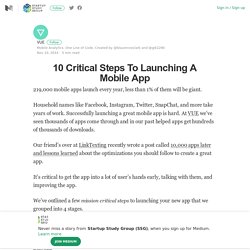

10 Steps To Launching A Mobile App — Startup Study Group. 219,000 mobile apps launch every year, less than 1% of them will be giant.

Household names like Facebook, Instagram, Twitter, SnapChat, and more take years of work. Successfully launching a great mobile app is hard. At VUE we’ve seen thousands of apps come through and in our past helped apps get hundreds of thousands of downloads. Our friend’s over at LinkTexting recently wrote a post called 10,000 apps later and lessons learned about the optimizations you should follow to create a great app. It’s critical to get the app into a lot of user’s hands early, talking with them, and improving the app. We’ve outlined a few mission critical steps to launching your new app that we grouped into 4 stages. Stage 1: Marketing The Initial Idea Use the following steps to attain hundreds or thousands of beta testers for your new app 1) Setup Facebook Page/Twitter account These are the two must haves, you can expand to Tumblr, Instagram, etc. accounts, whatever is best for your app Reward best practices. The simplest and most important dashboard for early stage startups.
This blogpost is part of a small series of posts that cover the basics of startup metrics.

My personal goal is to help early stage startups more effectively, but also avoid repeating myself too much in mentoring programs. If you are working on a software product in early stage of its lifecycle this series might be useful for you. Other posts in this series. If there are special topics you’d like me to cover please ping me via @andreasklinger. Also if you consider them useful please be so kind and tweet this article. Early Stage Startup Metrics One of the most common pieces of advice is that in early stage you want to focus on retention. Retention = f(customer happiness) It’s simple: If people are not happy with your product and/or gain no benefit by using it they will most not continue using it. And automatically cool visualisations like retention cohort tables come to mind.
Please don’t get fancy too early. Add activity information to this table. Dummy mockup is dummy Seriously? Andreas. Best Practices and Resources for Financial Modeling. In addition to Foresight’s financial model templates for startups and investors, here’s a list of valuable best practices, resources and templates from around the web.

Missed one? Contact me. General Startup Financial Model Excel Templates (Free) Sign Up. Lessons learned from scaling a product team. There’s been lots written about how Internet businesses should build software, from books like The Lean Start-Up, and posts from Google Ventures, but not many examples where startups open up their process and show how it really happens.

Back in 2013, Spotify talked about how they build, but other detailed examples are hard to find. Maybe that’s because it’s a messy reality and people can be uncomfortable sharing that in public. Given the abundance of abstracted advice, primarily from advisors rather than operators, and lack of actual examples happening from fast growing startups, we thought it would be valuable to share more about how we work at Intercom. In the last 12-18 months, over dozens of releases from incremental improvements to huge redesigns, we’ve learned a lot about scaling a product building team, and the nitty gritty involved in getting valuable product out the door as fast as possible. Our process is broken down into four main areas: Some things to keep in mind: 1. 2. 3. 17 Venture Capital Blogs You Should Be Reading.
Whether or not you’re raising money for your business, getting advice from venture capitalists can be invaluable.

But, getting in the doors of a Sand Hill Road VC in Silicon Valley can be an incredibly difficult undertaking. Fortunately, many of the top VCs share their thoughts on their blogs and are full of advice for startups, both big and small. Here’s a list of our favorite VC blogs, in alphabetical order. I like to follow these blogs through Feedly, but you can often sign up to get email alerts for new posts from most of these blogs. Inside the Minds of Top Venture Capitalists: Blogs You Need to Read to Understand How VCs Think.